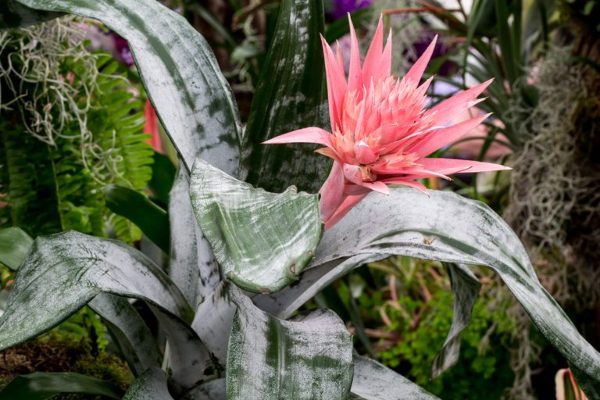Aechmea is a genus of flowering plants from the Bromeliad family. This houseplant has vibrant foliage ranging from pale gray to dark red and is also highly sturdy. Its leaves are tough and edged with sharp spines. There is also a bright pink flower blooming in the central part of the plant, adding vibrant colors and a striking appearance to this plant.
We are going to cover everything you need to know about Aechmea including the care tips, variations, and ways to grow and maintain these lovely plants.
Overview
Plant Type: Flowering Plant
Family: Bromelioideae
Genus: Aechmea, Ruiz & Pav.
Scientific Name: Aechmea
Native Area: South America
Toxicity: Non-toxic
Brief Introduction to Aechmea
Aechmea plants belong to the Bromeliaceae family, which includes over 3,400 species. It is a popular type of evergreen plant with rosettes of variegated or banded leaves in silvery grey, often with spiny edges. A beautiful, long-lasting, bright pink flower grows in the center. Aechmea, also commonly known as the “urn plant”, because of its arching leaves that form the shape of an urn. Well, these leaves can hold water which helps the plant collect and store rainwater dew in the rainforest. These plants are epiphytic, meaning they grow on trees, rocks, or other plants in nature.
Varieties of Aechmea
Aechmea blumenavii
Aechmea Blumenavii features soft green leaves in an upright rosette. It has a striking inflorescence featuring a fuzzy spike and a cylindrical cluster of bright yellow flowers with pinkish ovaries. This plant is further known for its ability to withstand cold temperatures and can be used in various settings, making it a popular choice for both tropical gardens and indoor displays.
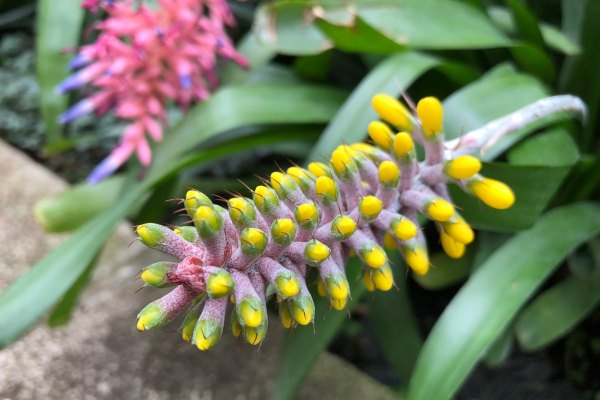
Aechmea rhodocyanea
Aechmea rhodocyanea, also known as A. Fasciate, is one of the best species in the genus. This flowering plant is mainly grown indoors and is recognized for its exceptional flowers that can last up to six months. The leaves on the plant are greenish-gray in color, with a large pink bract, actually purple, holding small blue flowers. This colored bract stays colorful for six months. It dies after flowering, from the center where the bract grew. Then, from the bottom of the main stem, small new plants start to grow. Aechmea fasciata requires good filtered light for blooming, but it grows well indoors if the light is adequate.
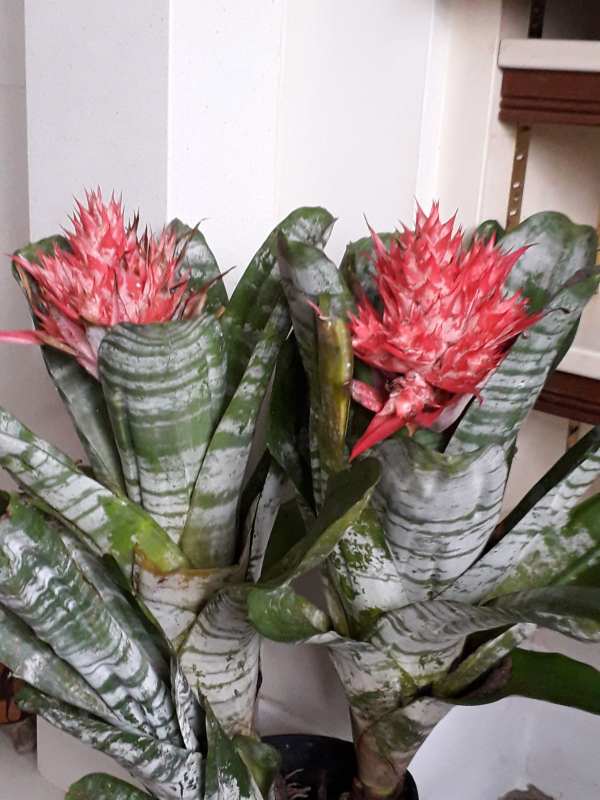
Aechema Chantinii
Aechema Chantinii probably is one of the most exceptional forms of the species. Its deep black and green colors with frosted bands make it very eye-catching. This plant can grow quite large, up to 30 inches tall and 18 inches wide. In South Florida, it is often grown in landscapes where they receive full sun. It also looks great mounted on decorative wood or in trees. Since this plant comes from a very tropical habitat, it is more sensitive to cold than most other Aechmeas.
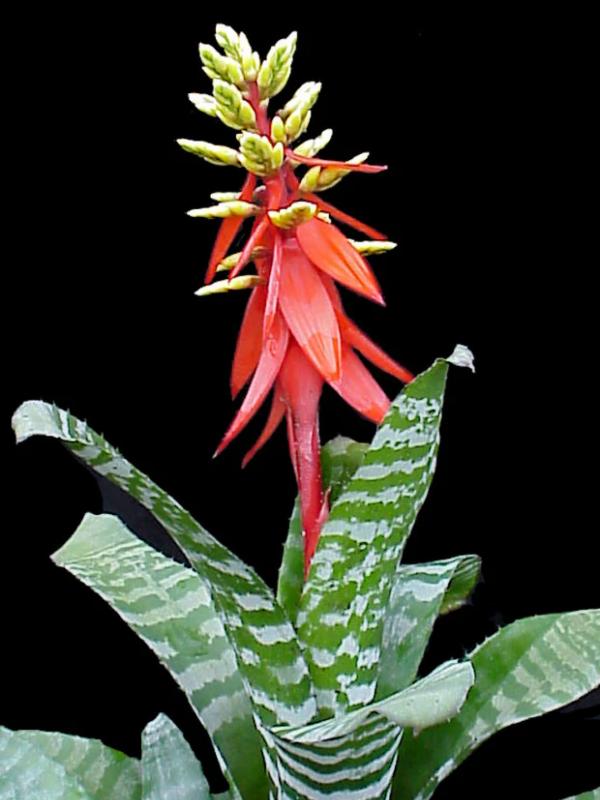
Aechmea Fosteriana
Aechmea Fosteriana is a striking bromeliad known for its tall, tubular shape and robust growth. It features long, strap-like leaves that are green with a grayish coating and dark-mottled bands. Similarly, the plant produces a semi-hanging flower spike with clusters of short yellow branches and rose-colored bracts. It thrives in tropical landscapes and is often mounted on trees or wood surfaces, forming large colonies on vertical trunks.
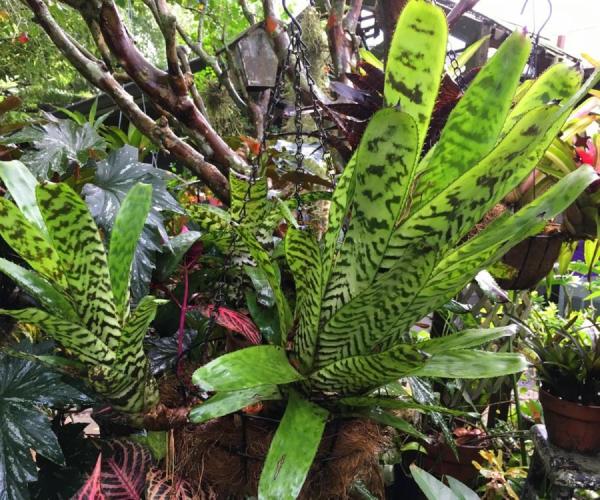
Essential Care Tips for Aechmea
Light
Soil and Water
Aechmeas are epiphytes so they naturally grow attached to other plants or even rocks in their native environment. If you are growing Aechmeas in your home, use a loose soil mix that drains well to maintain good moisture levels. However, keep the soil lightly damp. Make sure the central vase always has water and change it every month to stop it from getting stagnant and causing the plant to rot.
Temperature and Humidity
The plant prefers moderate to warm temperatures, ideally between 59-70°F (15-21°C). It can tolerate slight temperature changes, but avoid extreme heat or cold. If grown outdoors, they should be brought indoors or protected during colder months. While it doesn’t require specific humidity levels, these plants thrive better in a humid environment when watering.
Fertilizing
Pruning and Repotting
Pruning Aechmea helps to maintain its appearance and promote future growth. It is typically necessary only once every two years on average. These plants have small roots, so you probably won’t need to repot them.
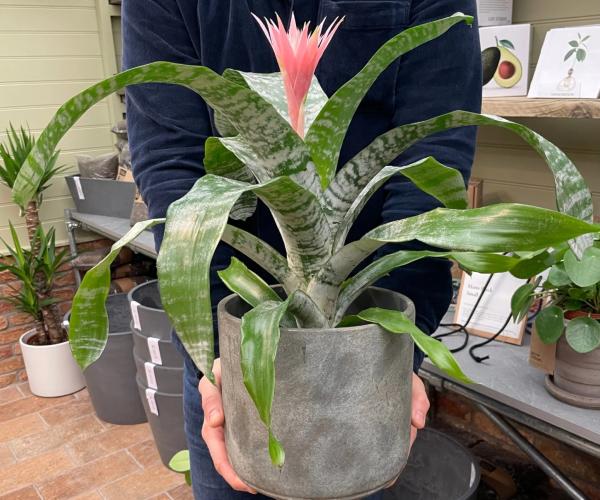
Pests and diseases
Common pests including mealybugs, scale, and aphids are commonly attracted to Aechmeas, which can lead to fungal infections. To control this, apply insecticide or enhance drainage and avoid excessive fertilization to prevent such issues.
How to propagate Aechmeas?
Aechmeas reproduce easily through pups, or baby plants, that grow alongside the parent. To propagate, cut the main plant right at ground level. Using a sharp knife, simply cut a pup when it’s about one-third to half as large as the mature plant. Allow the surface to dry for one or two days before potting in sharp-draining compost in a new pot. If necessary, support with a thin stake and maintain at a location at 64–70°F temperature.
Also read, Alstroemeria (Peruvian lily) Step-by-step: Planting, Growing, and Caring
Frequently Asked Questions
1. What type of plant is Aechmea?
Aechmea is a genus of bromeliads known for their vibrant foliage and striking flower spikes.
2. What is the ideal light condition for growing Aechmea?
Aechmea thrives in indirect light or moderate shade, not direct sunlight. These plants prefer bright, but not gloomy spots to keep their leaves vibrant and colorful.
3. Can Aechmeas tolerate cold temperatures?
No, Aechmeas prefers moderate to warm temperatures, ideally between 59-70°F (15-21°C). If grown outdoors, they should be brought indoors or protected during colder months.
